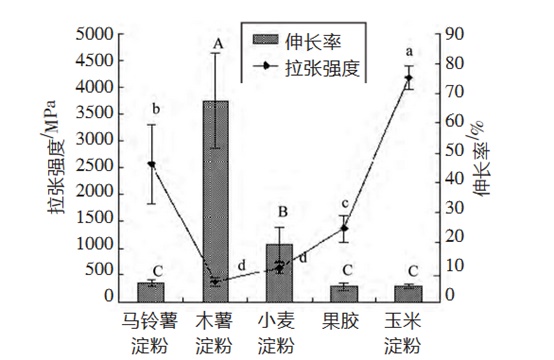LLOYD texture analyzer for the determination of tensile strength and elongation of starchy edible film
Food preservation materials that have been used in the market all the time are polyethylene plastic products produced from petroleum raw materials. The barrier properties and mechanical properties of such plastic products make plastic products widely used, but the biodegradability of plastic products causes serious environmental pollution. Edible film has direct edible and biodegradable properties and can be used as a new environmentally friendly food packaging material. Since the edible film has a low water vapor transmission rate, it is applied to the preservation of fruits and vegetables.
The barrier properties of edible film with starch as a substrate are not only affected by the difference in amylose and amylopectin content in starch, but also by plasticizer. Since the starchy edible film is easily cracked after being dehydrated, the polyol is added as a plasticizer to increase the integrity of the edible film after drying.
1. Preparation of edible film
Starch edible film production process: dry matter quality (starch, sorbitol and xylitol) and water quality ratio of 5%. Different amounts of sorbitol and xylitol were weighed, and the mass ratio of sorbitol to xylitol was 1:1, and the polyol was dissolved in water. After adding the starch, the mixture was continuously stirred and boiled for 4 minutes, cooled to 50 ° C, and stirred to remove the bubbles. 8 mL of the starchy film solution was poured into a polyethylene plastic plate having a diameter of 9 cm, and air-dried at 25 ° C for 12 hours to remove the film.
Pectin edible film production process according to NMaftoonazad et al. by the response surface method to optimize the minimum water vapor transmission rate of the membrane formulation: pectin and water mass ratio of 3% into water, continuous stirring at room temperature until the pectin is completely dissolved. Add 0.9% sorbitol and continue stirring until dissolved. Add 1.2% beeswax, heat the solution in a boiling water bath until the beeswax is completely melted, and immediately homogenize for 1 min at 13000 r/min. 8 mL of the pectin film solution was poured into a polyethylene plastic plate having a diameter of 9 cm, and air-dried at 25 ° C for 12 hours to remove the film.
2. Determination of tensile strength and elongation of edible films
The five edible films were cut into a rectangular shape of 10 mm width and 100 mm length in accordance with the ASTM D8822010 method. The mixture was equilibrated at 25 ° C, RH 50% for 48 h, and the tensile strength (TS) and elongation (E) were measured by a LLOYD texture analyzer , and the probe spacing was 50 mm. Each edible film was made up of 6 parallels.
TS=F/S effective (MPa)
In the formula, F—the maximum force during elongation, N; S effective—membrane stress cross-sectional area, m 2 .
E%=(L break-L original)/L original %
Where L fracture—film length at break, mm; L original—film original length, mm
3. Measurement results

The tensile strength of the tapioca film was significantly lower than that of the other groups, reaching 364 MPa, and the elongation was significantly higher than the other groups, reaching 67.5%. The corn starch amylose film has the highest tensile strength, reaching 4186 MPa.
There was no significant difference in the elongation of potato starch, pectin and corn starch. The difference in elongation and tensile strength between cassava starch film and corn starch film is increased, probably due to higher amylose content of corn starch (28%) and lower amylose content of cassava starch (17%). of.
Studies have found that tensile strength increases with increasing amylose content. Amylose aging, molecular chains combine to form a double helix structure, while amylopectin is mostly in an amorphous form with strong fluidity. The higher the amylose content, the tighter the starch network structure, the higher the tensile strength and the smaller the elongation.
Erythritol For Jam,Erythritol Alcohol,Canderel Erythritol,Erythritol Made Of
Ningxia Eppen Biotec CO.,LTD , https://www.nxeppen.com